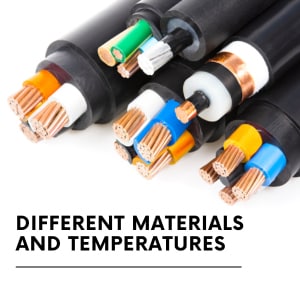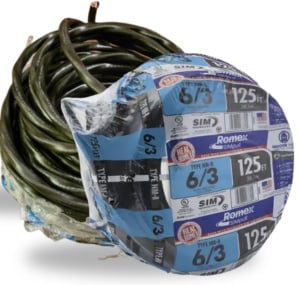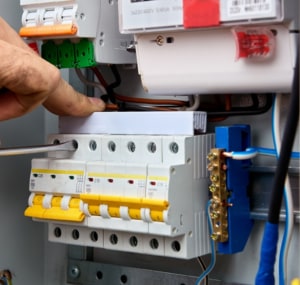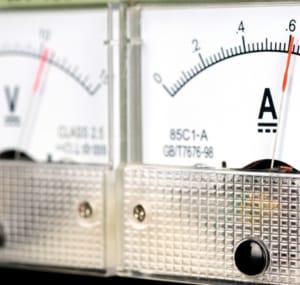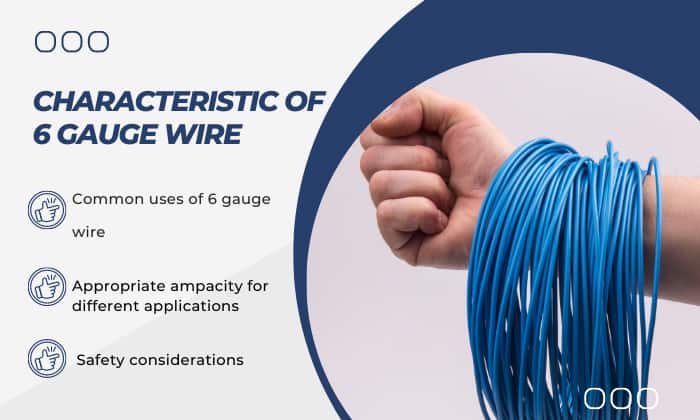6 gauge wire is commonly used in residential electrical connections of some appliances. To reduce the electrical hazards when using 6 gauge wire, we check how many amps can a 6 gauge wire handle.
If not more than three conductors are in a raceway, conduit or earth, 6 gauge copper wire can handle 55 amps at 140⁰F while 6 gauge aluminum wire can handle 40 amps at 140⁰F. These wires have larger amp ratings at higher temperatures.
Table of Contents
Amps Rating
1. Wire material and insulation
The material of the wire and its insulation are the primary factors that determine the amp rating.
The ratings based on these two factors are listed in the US National Electric Code or NEC, and we’ve summarized them at three different temperatures in both a conduit or raceway and free air.
|
6 AWG wire ampacity of different materials and temperatures |
||||||
|
Wire material |
Copper |
Aluminum or copper-clad aluminum |
||||
| Temperature | 140⁰F | 167⁰F | 194⁰F | 140⁰F | 167⁰F | 194⁰F |
| Insulation | TW and UF | Includes RHW, ZW, XHWN and USE among others | Includes PFA, SIS, TBS, XHHW-2 and ZW2 among others | TW and UF | Includes RHW, ZW, XHWN and USE among others | Includes PFA, SIS, TBS, XHHW-2 and ZW2 among others |
| Current rating of wire a raceway, cable or direct burial with not more than 3 current carrying conductors | 55 amps | 65 amps | 75 amps | 40 amps | 50 amps | 55 amps |
| Current rating of a wire in free air | 80 amps | 95 amps | 105 amps | 60 amps | 75 amps | 85 amps |
The table shows wire ampacities for both copper and aluminum. It also lists some of the insulating materials that can tolerate the heat at certain temperatures.
2. Wire length
Generally, the current rating is not changed by the length of the wire. But how far you can 6 gauge wire carry current might be affected by voltage drop.
Voltage drop happens when the current will experience a greater internal resistance from the wire.
The voltage drop for branch circuits is recommended to not exceed 3% according to the NEC. We’ve prepared a table listing the wire lengths for copper and aluminum wires to meet this recommendation:
|
Maximum wire length of 6 gauge wire at different voltages |
||||||
|
Wire material |
Copper |
Aluminum or copper-clad aluminum |
||||
| Max amps and Temperature | 55 amps
140⁰F |
65 amps
167⁰F |
75 amps
194⁰F |
40 amps
140⁰F |
50 amps
167⁰F |
55 amps
194⁰F |
| 12V | 7 ft | 5.5 ft | 4.5 ft | 6 ft | 4.5 ft | 3.9 ft |
| 24V | 14 ft | 11 ft | 9 ft | 12 ft | 9 ft | 7.8 ft |
| 120V | 71 ft | 57 ft | 47 ft | 60 ft | 45 ft | 39 ft |
| 240V | 142 ft | 114 ft | 94 ft | 120 ft | 90 ft | 78 ft |
3. Different 6 AWG cables
Multiple insulated 6 gauge wires can be bundled together in a sheath to make a multi-conductor cable. These cables are labeled with two numbers – the gauge of the wire and the number of conductors.
For example, Romex 6/3 wire by Southwire uses 6 gauge wire and has 3 current carrying conductors.
6 gauge cables generally have the same current rating with a single current-carrying wire. Romex 6/3 wire is rated at 55 amps, just like a single 6 gauge THHN wire.
4. Applications of 6 gauge wire
6 gauge copper wire is used in residential connections.
Generally, 6 AWG wire used for residential connections is limited to 140⁰F since homes have panelboards rated at 600V or less at 140⁰F too. Thus, the maximum rating for 6 gauge wire at home will be 55 amps.
Branch circuits with continuous loads, though, will be limited to 80% of the current rating of the wire. This limitation accounts for the effect of excess heat on the overcurrent protection device like a circuit breaker.
5. How to calculate amps
We’ve provided tables for 6 gauge wire amps and estimated length for your convenience. Calculating the actual current flowing through 6 gauge wire can be very tedious and may be done best by a certified electrician or an engineer.
If you need specific ampacities for certain voltages (like an exact amp rating for 220 volts), then we suggest you use an online calculator. These websites can factor in different correction factors and conditions NEC listed for a more accurate estimate of current carrying capacity.
One thing that you can surely calculate, though, is how many amps is 6 gauge wire good for in a branch circuit with continuous loads. Just multiply our current ratings by 80%:
\[ \text{Current}_{80\% \text{ amps}} = 6 \text{ AWG rating} \times 0.80 \]
If 6 gauge copper wire in a residential setting is limited to its 140⁰F rating, then the current that can flow to this wire will be:
\[ \text{Current}_{80\% \text{ amps}} = 6 \text{ AWG rating} \times 0.80 \ = 55 \times 0.08 = 0.44 \text{amps}\]
6. Wattage chart of a 6 gauge wire
While the current rating is standard in wires, appliances are commonly expressed in watts. So, the maximum watts a wire can deliver is sometimes more convenient to look at. Here is a chart estimating the wattage of wires based on their voltage:
|
Wire wattage at different voltages |
||||||
| Wire material | Copper |
Aluminum or copper-clad aluminum |
||||
| Max amps and Temperature | 55 amps
140⁰F |
65 amps
167⁰F |
75 amps
194⁰F |
40 amps
140⁰F |
50 amps
167⁰F |
55 amps
194⁰F |
| 12V | 660 watts | 780 watts | 900 watts | 480 watts | 600 watts | 660 watts |
| 24V | 1320 watts | 1560 watts | 1800 watts | 960 watts | 1200 watts | 1320 watts |
| 120V | 6600 watts | 7800 watts | 9000 watts | 4800 watts | 6000 watts | 6600 watts |
| 240V | 13200 watts | 15600 watts | 18000 watts | 9600 watts | 12000 watts | 13200 watts |
The watts listed are based on the definition of electric power. Electric power is simply the current rating multiplied by the voltage.
7. Common Wire Ampacity Factors
1. Material of the wire
Wire materials may vary in their ability to allow current to flow. Some materials allow more current than others. For instance, copper wires have better current ratings than aluminum because copper is a better conductor.
2. Wire insulation
Wires are insulated based on their use. Some insulating materials are used in corrosive environments while others are limited to indoor applications. They also have different temperature tolerances that limit their application.
Real-world Applications of 6 Gauge Wire
1. Common uses of 6 gauge wire
6 gauge wire is used in houses to provide 40 to 50 amps of current to high-powered devices like electric ranges. It can be used in appliances if the appliance does not exceed the power rating on our wattage chart.
It can also be used in cars. It’s found in a wiring kit of a car amplifier at 12 volts and can either come in oxygen-free copper (OFC) or copper-clad aluminum (CCA).
2. Appropriate ampacity for different applications
For 6 gauge wire at home, it’s common to use the 80% capacity at 140⁰F. Thus, residential use of 6 gauge wire is limited to 44 amps.
For 6 gauge wire in car amplifiers, check the maximum watts of the car amplifier before buying the car amp kit. A 500-watt car amplifier system can be handled smoothly by a 6 gauge OFC wire.
3. Safety considerations
One consideration is the wire’s insulation. Since the current flow heats the wire, the insulation must be suitable for the current rating to prevent fires caused by damaged insulation. The NEC provides a complete list based on temperature, but we’ve listed some of them in our tables.
Another thing to consider is the wire length. We’ve listed the estimated lengths for 6 gauge wires to limit voltage drop to ensure that the appliances will work in their optimal conditions.
Conclusion
6 gauge wire can be safely used at home and in cars. They can be in copper or aluminum form and have different current ratings at various temperatures.
How many amps can a 6 gauge wire handle may vary depending on the wire material and wire insulation. Looking at the capacity of a 6 gauge wire can help you safely plan your circuits to power your appliances to their optimal performance without risks of electrical hazards.

I am Edwin Jones, in charge of designing content for Galvinpower. I aspire to use my experiences in marketing to create reliable and necessary information to help our readers. It has been fun to work with Andrew and apply his incredible knowledge to our content.


